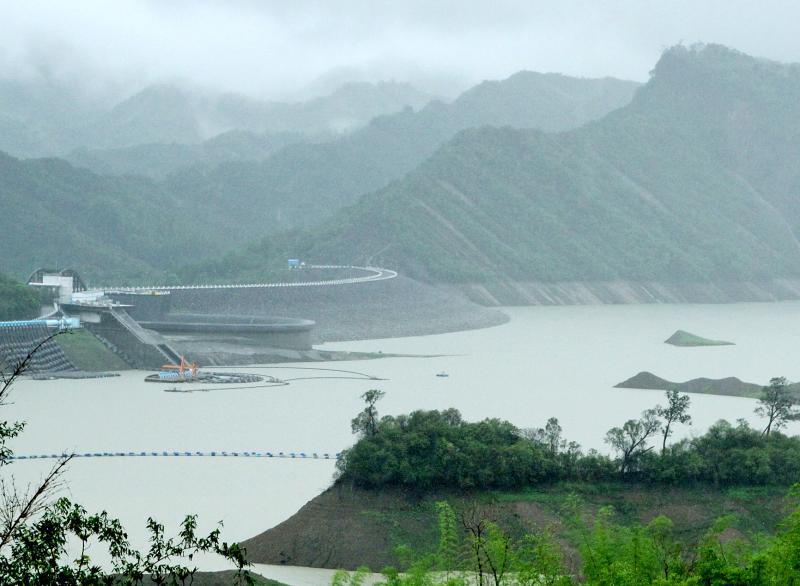Timely plum rains have significantly alleviated a historic water shortage in Taiwan, allowing water restriction measures to be lifted in some areas, while the hardest-hit areas remain on alert, the Ministry of Economic Affairs (MOEA) said yesterday.
“Thanks to Tropical Storm Choi-Wan, the sustained plum rains and continued water resource management efforts, the water situation in Taiwan has been greatly alleviated,” Minister of Economic Affairs Wang Mei-hua (王美華) told an online news conference.
More than 100mm of rain has fallen in the catchment areas of the reservoirs in Miaoli and Taichung counties over the past few days, Water Resources Agency data showed.

Photo: Wu Chun-feng, Taipei Times
Before the seasonal plum rains arrived late last month, Taiwan had gone almost a year without significant rainfall in the catchment areas of reservoirs.
Early this year, the nation turned to alternate sources of water, such as an emergency desalination plant in Hsinchu County and a pipeline between Taoyuan and Hsinchu, as well as emergency wells and other unconventional sources of water, to ensure industrial production continues unhindered.
Still, some areas in central Taiwan were placed under “red alert,” meaning that households and businesses received water only five days a week.
Nantou County and Kaohsiung, which were on “yellow alert,” or reduced water pressure overnight, are now back to normal, the ministry said.
Southern Changhua County and Yunlin County are on “green alert,” the lowest level of warning with no water restrictions, it said.
“Green alert” industrial users are required to reduce daily water consumption by 5 percent, it added.
Taoyuan, Tainan and Taichung, as well as Hsinchu, Miaoli, Chiayi counties and northern Changhua County, remain on “orange alert,” with water pressure reduced overnight and daily water restrictions for large users, the ministry said.
Large industrial users in these areas have to reduce daily water consumption by 7 percent, while non-industrial large users, such as car washes, need to reduce consumption by 10 percent, it said.
The water shortage was exacerbated by silt buildup in the nation’s reservoirs, reducing their overall usable capacity, the Water Resources Agency said.
The government has made maximum use of the low water levels to clear more than 10 million cubic meters of silt from reservoirs, the largest volume removed in the past few years, the agency said.
The latest rains raised the levels in many reservoirs, but did not fill all of them, meaning Taiwan is not out of the woods, it said.
With the possibility of more stormy weather, the agency is simultaneously preparing for drought relief and flood relief, it added.

GROWING OWINGS: While Luxembourg and China swapped the top three spots, the US continued to be the largest exposure for Taiwan for the 41st consecutive quarter The US remained the largest debtor nation to Taiwan’s banking sector for the 41st consecutive quarter at the end of September, after local banks’ exposure to the US market rose more than 2 percent from three months earlier, the central bank said. Exposure to the US increased to US$198.896 billion, up US$4.026 billion, or 2.07 percent, from US$194.87 billion in the previous quarter, data released by the central bank showed on Friday. Of the increase, about US$1.4 billion came from banks’ investments in securitized products and interbank loans in the US, while another US$2.6 billion stemmed from trust assets, including mutual funds,

AI TALENT: No financial details were released about the deal, in which top Groq executives, including its CEO, would join Nvidia to help advance the technology Nvidia Corp has agreed to a licensing deal with artificial intelligence (AI) start-up Groq, furthering its investments in companies connected to the AI boom and gaining the right to add a new type of technology to its products. The world’s largest publicly traded company has paid for the right to use Groq’s technology and is to integrate its chip design into future products. Some of the start-up’s executives are leaving to join Nvidia to help with that effort, the companies said. Groq would continue as an independent company with a new chief executive, it said on Wednesday in a post on its Web

JOINT EFFORTS: MediaTek would partner with Denso to develop custom chips to support the car-part specialist company’s driver-assist systems in an expanding market MediaTek Inc (聯發科), the world’s largest mobile phone chip designer, yesterday said it is working closely with Japan’s Denso Corp to build a custom automotive system-on-chip (SoC) solution tailored for advanced driver-assistance systems and cockpit systems, adding another customer to its new application-specific IC (ASIC) business. This effort merges Denso’s automotive-grade safety expertise and deep vehicle integration with MediaTek’s technologies cultivated through the development of Media- Tek’s Dimensity AX, leveraging efficient, high-performance SoCs and artificial intelligence (AI) capabilities to offer a scalable, production-ready platform for next-generation driver assistance, the company said in a statement yesterday. “Through this collaboration, we are bringing two

Even as the US is embarked on a bitter rivalry with China over the deployment of artificial intelligence (AI), Chinese technology is quietly making inroads into the US market. Despite considerable geopolitical tensions, Chinese open-source AI models are winning over a growing number of programmers and companies in the US. These are different from the closed generative AI models that have become household names — ChatGPT-maker OpenAI or Google’s Gemini — whose inner workings are fiercely protected. In contrast, “open” models offered by many Chinese rivals, from Alibaba (阿里巴巴) to DeepSeek (深度求索), allow programmers to customize parts of the software to suit their